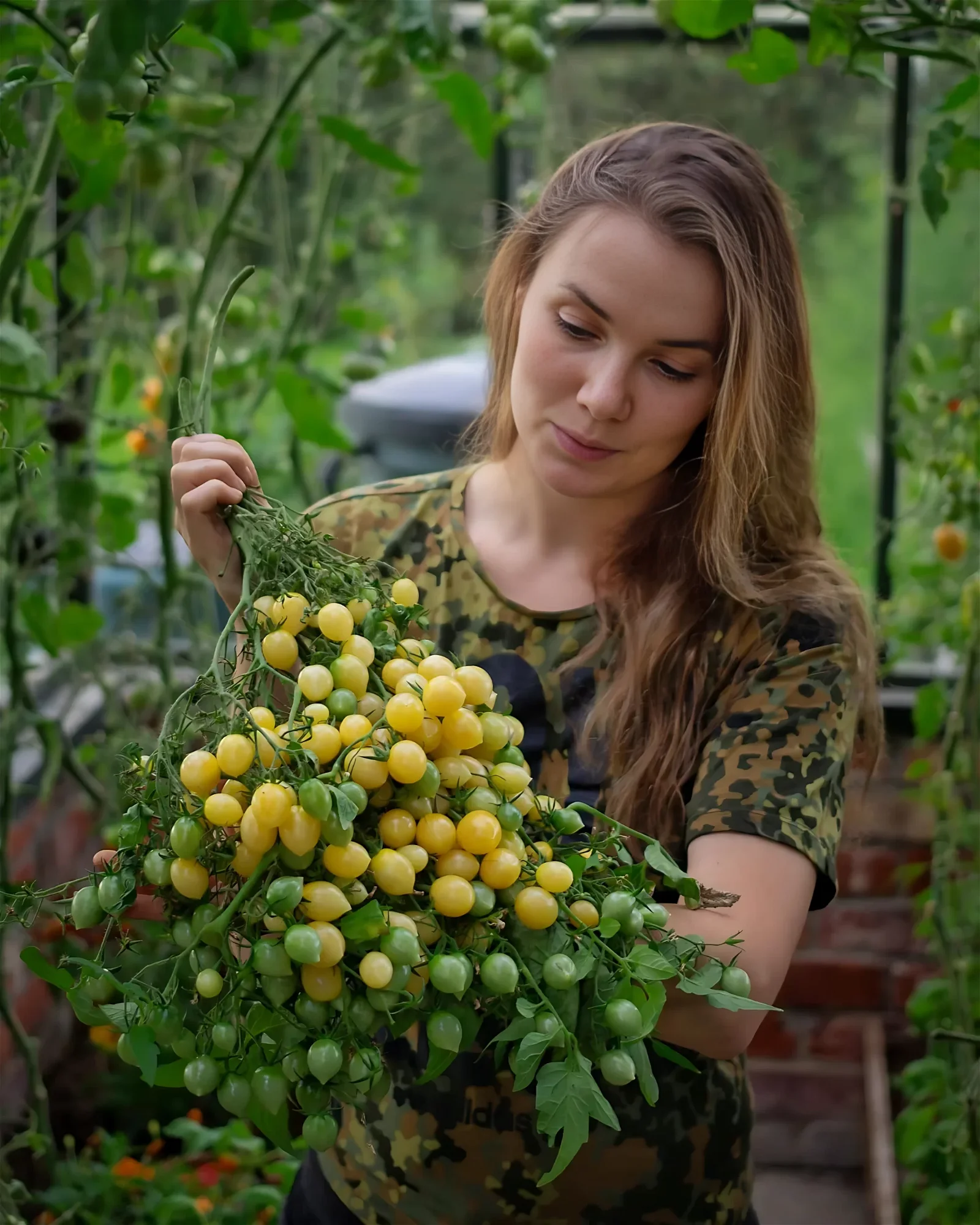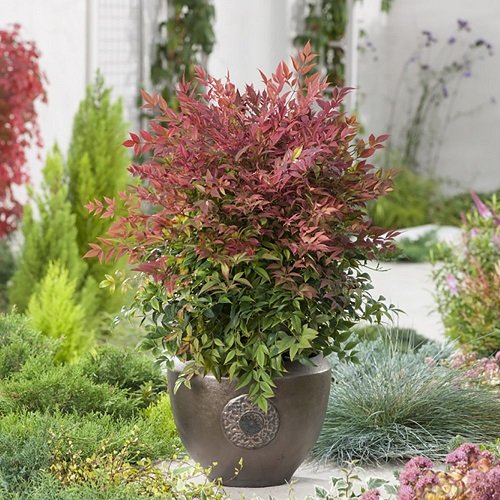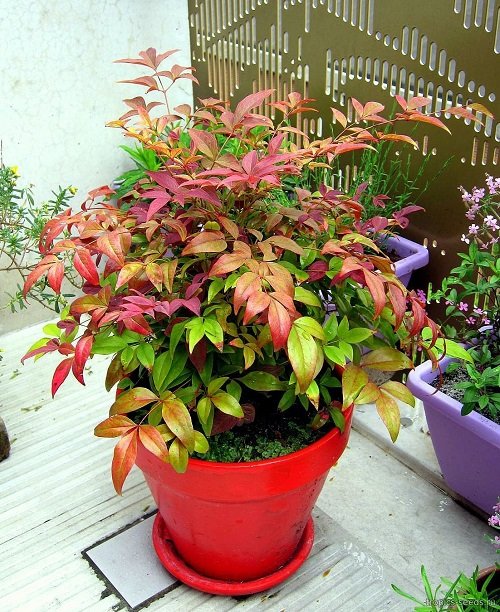Bring a touch of elegance and color to your patio or balcony by Growing Nandina Domestica in Pots with our expert guide!

Growing Nandina Domestica in Pots? Here’s all you need to know! These beautiful plants are perfect for container gardening, offering a range of varieties that are both easy to care for and stunning to behold.
Here are Types of Bamboos to Grow in Containers and Gardens
Nandina Domestica Plant Information
Nandina domestica, commonly known as Heavenly Bamboo, is an attractive and versatile ornamental plant belonging to the family Berberidaceae. This family includes various flowering plants known for their distinctive foliage and berries. Nandina is not actually related to bamboo, despite its common name.
Wondering how tall do nandinas grow? This evergreen shrub grows to a height of 4 to 8 feet (1.2 to 2.4 meters) and has a dense, upright, and bushy habit. The leaves are divided into leaflets arranged along delicate stems, giving the plant its misleading common name. The foliage has a lacy, fern-like appearance, with colors ranging from vibrant green to shades of red, bronze, or purple during colder seasons.
One of the most appealing features of Nandina domestica is its showy berries. The small, round nandina berries appear in clusters, initially green, then transitioning to shades of red, pink, or white, depending on the variety and maturity.
Here are Plants that Look like Lucky Bamboo
Propagating Nandina Domestica
Nandina domestica can be propagated through three main methods: seeds, division, and stem cuttings. Seed propagation is the least recommended option due to unpredictable results and slow growth. Division involves separating established plants into smaller clumps, but it’s not always reliable.
The most successful and preferred method for Growing Nandina Domestica in Pots is via stem cuttings. Here is how to propagate Nandina Domestica from cuttings.
- Select a healthy parent plant in early spring or late summer for taking cuttings.
- Using sharp, clean pruning shears, take 4 to 6-inch (10 to 15 cm) stem cuttings from new growth, ensuring they have at least two or three sets of leaves.
- Trim off the lower set of leaves, leaving only the upper leaves to reduce moisture loss during rooting.
- Use a well-draining rooting medium, such as a mix of perlite and peat moss, in a small container.
- Insert the cut end of the stem into the rooting medium, making sure at least one set of leaf nodes is below the surface.
- Place the container in a warm and bright location, but avoid direct sunlight, as excessive heat can damage the cuttings.
- Keep the rooting medium consistently moist but not waterlogged to encourage root growth.
- Once the cuttings have developed a healthy root system, gently tug on the base of the plant to check for resistance, indicating successful rooting.
And that’s it! When the roots are well-established, carefully transplant the new Nandina plants into individual pots or desired garden locations.
Propagate Any Plant Cutting Quickly Using this Trick
Best Pot for Nandina Domestica
When starting with a young Nandina, choose a container that is slightly larger than its current root ball, providing enough room for its roots to expand. A pot with a diameter of 8 to 10 inches (20 to 25 cm) should suffice for a small plant.
As the Nandina matures and its root system develops, consider transplanting it into a larger container with a diameter of 12 to 16 inches (30 to 40 cm) or more. This will allow the plant to continue growing and prevent root crowding.
Using a well-draining potting mix and providing proper care when Growing Nandina Domestica in Pots will help your plant thrive and create an attractive display.
Here are Plant Pot Sizes from Inches to Gallon
When to Plant Nandina Domestica
The best time to plant Nandina Domestica is during the early spring or late summer. These periods provide favorable conditions for the plant’s establishment and growth.
Planting in early spring allows the Nandina to take advantage of the warmer temperatures and increasing daylight, promoting root development before the hot summer arrives. On the other hand, planting in late summer gives the plant a chance to establish its roots before the cooler fall and winter months.
By choosing these optimal times, you give your nandina heavenly bamboo the best chance to acclimate to its new environment and thrive in your garden or landscape.
How Long Does Lucky Bamboo Live? Find out!
Requirements for Growing Nandina Domestica
Sunlight
Nandina Domestica thrives in full sun to partial shade. Do nandinas need full sun? If you’re planting it in an area that receives full sun, make sure it gets some shade during the hottest part of the day.
On the other hand, if you’re planting it in a shady spot, make sure it receives at least 4-6 hours of direct sunlight each day. Heavenly bamboo nandina domestica prefers a balance of sunlight and shade, so try to find a location that offers both.
A good location to consider would be a north-facing window or a spot.
Soil
This ornamental plant grows best in fertile, well-draining soil that is slightly acidic to slightly alkaline. A loamy soil with good organic content is ideal. Avoid waterlogged or compacted soils, as they can lead to root rot and hinder plant growth.
If the native soil is heavy or poor, amending it with compost or well-rotted manure before planting can improve the soil structure and provide essential nutrients for the plant’s development.
Find out some Helpful Hacks to Improve Your Garden Soil for Free here
Watering
Nandina Domestica prefers consistently moist soil, but it’s important not to overwater it. The best way to water your nandina is to give it a deep soak once a week rather than frequent shallow watering. This will encourage the roots to grow deeper into the soil, which will help the plant to withstand drought conditions better.
Here are the best ways to water plants
Do not water the plant on a daily basis, and do so only when the topsoil feels a little dry to the touch. During periods of hot, dry weather, you may need to water your Nandina more frequently to keep the soil moist.
Temperature and Humidity
Nandina Domestica is a hardy plant that can tolerate a wide range of temperatures, from 10°F to 110°F (-12°C to 43°C). However, it prefers temperatures between 60°F to 70°F (15°C to 21°C) for optimal growth.
As for humidity, it can adapt to different levels, but moderate to high humidity is generally favorable for its growth and overall well-being.
Here are 21 Practical Time Saving Tips For Busy Gardeners
Heavenly Bamboo Care
Fertilizer
Nandina Domestica benefits from regular fertilization to promote healthy growth and vibrant foliage. So, what is the best fertilizer for nandinas? Use a balanced, slow-release fertilizer during the growing season, typically in spring and early summer.
Avoid applying nandina fertilizer in late summer and fall to prevent encouraging tender new growth that might be susceptible to winter damage.
Here is the Best Fertilizer for Bamboo
Pruning
Pruning your Nandina Domestica plant is a great way to keep it healthy. So when to prune nandina? The best time to prune is in late winter or early spring before new growth emerges. Don’t know how to prune nandina? We’ve got you covered.
Just remove any damaged or crossing branches and thin out crowded nandina bushes to improve air circulation. Be cautious not to over-prune, as excessive cutting can lead to a loss of berries. Regular light pruning throughout the year can help maintain the plant’s desired size and shape.
Pests and Diseases
Nandina Domestica is generally a hardy plant with good resistance. There are little nandina problems, but it can be susceptible to some pests and diseases. Common pests that can affect the plant are spider mites, scale insects, and mealybugs. You can control these pests by using insecticidal soap or neem oil.
When it comes to diseases, the plant can be affected by powdery mildew, anthracnose, and botrytis blight. Make sure you never overwater and choose a location that lets Heavenly Bamboo get plenty of air circulation.
Here are Types of Common Pests in Your Garden & How to Get Rid of Them
Nandina Domestica Toxicity
It is important to note that the berries and leaves of Heavenly Bamboo are toxic to dogs, cats, and horses, and caution should be exercised when handling them. The cyanogenic glycosides inside Nandina berries are extremely harmful to pets.
Find the Plants with Toxic Sap here
FAQs
1. What Are the Types of Nandina Plants?
There are several types of nandina plants, also known as heavenly bamboo. Some popular varieties include “Nandina domestica,” “Nandina Gulf Stream,” “Nandina Firepower,” and “Nandina Lemon Lime.”
2. What Are the Different Nandina Varieties Available?
There are various cultivars or nandina varieties, each with unique characteristics. Some common Nandina varieties are “Harbour Dwarf,” “Obsession,” “Moon Bay,” and “Flirt.”
3. Are Nandina Bushes Safe for Dogs?
Wondering, is nandina toxic to dogs? Yes, Nandina plants are toxic to dogs if ingested. They contain compounds that can be harmful to pets, leading to symptoms like stomach upset, vomiting, and diarrhea. It’s essential to keep these plants out of reach of your furry friends.
4. What Are Some Companion Plants for Nandina?
Nandina plants can be beautifully complemented by various companion plants. Some suitable options include “Liriope” (Lilyturf), “Camellia,” “Fatsia japonica” (Japanese Aralia), and “Ajuga reptans” (Bugleweed). These plants can create an attractive and harmonious garden setting when planted alongside nandina bushes.




